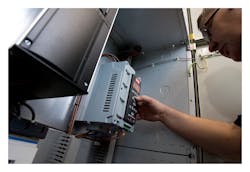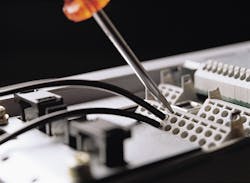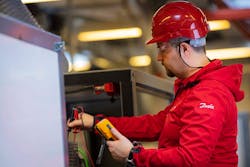Top 10 Ways to Protect Your VFD Investment
By JONATHAN MOSTERD, Engineering Manager, Danfoss Drives
As the cost of energy continues to rise, so does the increased demand for efficiency.
One of the ways many manufacturers are improving efficiency is through the use of variable speed drives (VFD) for electrical motors. Compared to "across the line" starters or older DC drives, variable AC drives are able to save users money by providing better motor control to operate the system at lower speeds and unity power factor. Over time, the payback from these savings reduces operating costs and provides a return on investment. However, this is only possible by ensuring the lifecycle of these units are maximized and optimized.
Here are 10 ways to protect your investment in a VFD:
1. Know your application. Protecting your VFD investment begins before you even purchase a VFD. Factors such as performance, speed or torque control, fieldbus communications, or even inputs and outputs can often affect the model of unit you will need. Taking the time to first determine your needs before you purchase can often differentiate between a successful project and one that keeps you up in the middle of the night;
2. Make sure your system is engineered properly. The VFD needs to be sized according to load and ambient conditions to ensure that it can handle the torque required in all situations. Be sure to consult with your VFD manufacturer who will have design resources available to support you;3. Evaluate at your environment. If it is contaminated with dust, conductive residue, debris, moisture, oil, high temperatures, or other potential disruptors, you may want to invest in a VFD that is rated NEMA 12 or NEMA 4 to protect it from these variables. Also consider temperature, altitude, and humidity and compare them to the manufacturer’s specifications. The electrical environment is also important and often overlooked; existing harmonics, stray voltages, imbalances, or line spikes can cause adverse effects to your new installation. Filters, reactors, and isolation transformers are other items that may be needed to ensure a properly operating environment;
4. Select the correct motor. Not all motors are created equal. Due to the nature of the pulse-width modulation (PWM) waveform that a VFD generates to produce a synthetic AC waveform, there is often high voltage spikes. VFD-rated motors are equipped with extra insulation and are designed to handle this. Be sure to consult with your motor manufacturer regarding speeds, duty cycle, isolated bearings, ground brushes, and environment. A good motor manufacturer will work with you to verify you are purchasing the best product for your application;
5. Specify the correct fusing, cabling, and filters. Before finalizing the installation, be sure to consult the installation manuals which come with the VFD. They will provide valuable information regarding compliant fuses and cables sizes and types (such as VFD Cable), as well as any external items you may need such as a load reactor to prevent things like reflective waves. Further, use the correct wiring and wiring practices during the installation process. A VFD cannot maintain its NEMA 12 or NEMA 4 rating if wiring practices and components of the same rating are not used;
6. Utilize trained and qualified professionals to install your equipment, especially in harsh environments. Manufacturers provide minimal standards for installation and often there are local electrical regulations which also need to be met. Further, a trained and qualified installer will be able to ensure that drives are mounted correctly, all wiring is bonded and grounded properly, the installation allows for proper airflow, and all covers and protective barriers have been reinstalled correctly;
7. Verify that those doing the start-up and commissioning are well-versed in VFD operation. Knowing and understanding how to properly enter the motor data, utilize PID controls, and establish field bus communications will help assure that you meet both budgets and deadlines during the installation;
8. Invest in training. Having a good working comprehension of variable AC drives will help you and maintenance staff to better understand what is considered normal and abnormal operation. By identifying abnormalities early, you could prevent unexpected failures and downtime and be able to better help troubleshoot when the unexpected does occur;
9. Perform regular maintenance. Like most electrical equipment, VFD manufacturers prescribe recommended maintenance intervals which should be followed. This will allow you to planned shut-down times to clean and inspect your unit, identify potential problems, and remove any items which may be preventing your equipment from properly dissipating heat. Also it allows you to chart standard operating conditions and identify if things are starting to break down, such as your electrolytic capacitors;
10. Invest in recommended spare parts and review them on a regular basis. It is one thing to purchase a spare unit, and another to actually use it. Many VFDs today have electrolytic capacitors, which, if left unused for more than a year, begin to deteriorate. This may cause the unused drive to spontaneously combust when finally installed. While it is important to have extra parts like fuses and control boards, as well as spare VFDs, on hand, it is just as important to regularly test and inspect them to ensure they are in good operating condition and ready for use should you need them.
It’s important to realize that anyone can purchase a VFD and install it. However, it is imperative that the installation process be followed precisely and accurately.
By spending the necessary time up front, investing in the correct products for your application, and by conducting regular maintenance, you can rest assured that you will reap the energy savings and operational efficiencies of a VFD for many years to come.
##########
Based in Beloit, WI, the author leads a team of VFD experts at Danfoss Drives' North American Center of Excellence. They partner with customers, OEM's and system integrator's to help design, commission and support VFD installations across a variety of verticals.



